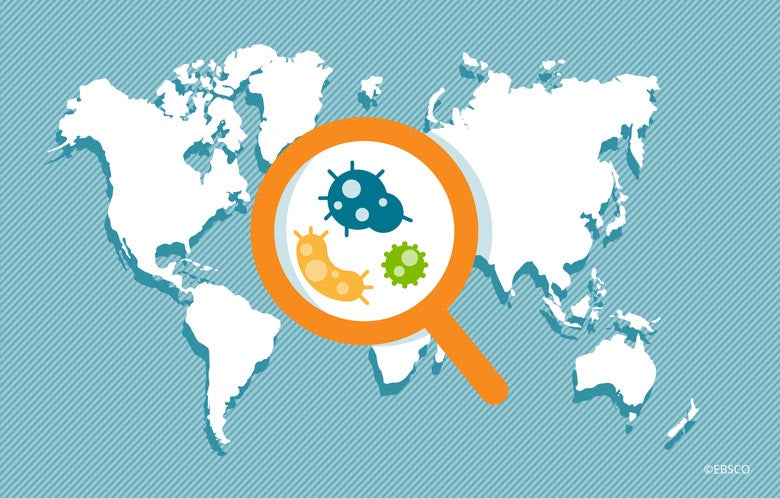In early 2015, a significant number of cases of a mild illness with rash, fever, arthralgias, and conjunctivitis were reported in Brazil. Tests for the likely culprits Dengue virus and Chikungunya virus were negative. On a long-shot, researchers tested for a virus that had only caused a handful of human cases and had never been identified in the Americas — Zika virus, which turned up positive. In May of 2015 an outbreak of Zika virus in Brazil was confirmed by the World Health Organization (WHO).
By the fall of 2015, millions of cases had been reported across South and Central America, there were reports of an increase incidence of babies born with microcephaly, and physicians started asking the editors of DynaMed for information.
Flash forward to today and we are facing a similar scenario. In late December 2019, Chinese officials reported cases of pneumonia of unknown origin. Tests for Severe Acute Respiratory Syndrome Coronavirus (SARS-CoV) and Middle East Respiratory Syndrome Coronavirus (MERS-CoV) were negative, as were tests for other common culprits. Genetic sequencing has since revealed a novel coronavirus, cases continue to rise and spread, and physicians started searching DynaMed for answers. But much like the situation with Zika virus in 2015, DynaMed didn’t yet have information on this novel coronavirus.
How does DynaMed provide physicians the information they need during an emerging public health crisis?
First, to determine the need for content we primarily rely on the day-to-day experience of practicing physicians — including those of our editorial staff as well as physicians using DynaMed in clinics and hospitals around the world. In 2015 for example, an Infectious Disease topic editor informed us that she was getting calls from Obstetrics colleagues asking about the risks of travel for their pregnant patients, indicating a need for guidance. Second, we use data to inform content creation by looking at searches in DynaMed. A spike in searches for “coronavirus” in early 2020 was absolutely telling.
Then we collect whatever information is available and determine what type and scale of content is required. This can range from social media posts on Twitter and LinkedIn and articles on this blog, to the addition of sections of information and full DynaMed topics, and often proceed through this sequence as more data arises. Notably, early during an outbreak and prior to publication of studies, we only use reputable organizations such as the WHO, CDC, and regional health departments as sources of information. While news organizations publish articles based on interviews and press briefings, we know that DynaMed users require actionable and trustworthy knowledge, so we only report guidance from health authorities.
Due to the imminent impact the novel coronavirus outbreak has on public health, the DynaMed topic is freely accessible to physicians around the world, whether they are subscribers or not.
Due to the imminent impact the novel coronavirus outbreak has on public health, the DynaMed topic is freely accessible to physicians around the world, whether they are subscribers or not.
When the novel coronavirus was first identified in early January, our first action was to share information from the WHO on social media. After the WHO released its first Situation Report on January 21, we wrote a blog post with more details on the case numbers and spread, and initiated creation of a section in the related MERS-CoV DynaMed topic, which was published on January 24. Almost as soon as that section was live in DynaMed, we recognized that we had enough information from WHO and CDC for a full stand-alone topic, which was published along with a summary of the first Lancet cohort study on January 27. Due to the imminent impact the novel coronavirus outbreak has on public health, the DynaMed topic is freely accessible to physicians around the world, whether they are DynaMed subscribers or not.
Since publication of the topic, the epidemiology has been updated every weekday, guidelines and resources have kept up with WHO, CDC, and other regional organizations as they amend their guidance documents, and risk categories and infection control instructions were added as they became available. Notably, the topic also got a title change when the WHO announced on February 13 that the disease caused by the novel coronavirus should be known as COVID-19. The novel virus also got named SARS-CoV-2 by the International Committee on Taxonomy of Viruses.
Research on the novel coronavirus and the COVID-19 disease it causes have been initiated at break-neck speed. Four cohort studies describing clinical presentation, laboratory findings, and complications of hospitalized patients with COVID-19 pneumonia were published by the end of February. These studies revealed that fever, fatigue, and cough are the most common presenting manifestations of COVID-19. Lymphopenia is a frequent lab finding and bilateral ground glass opacities are typical on chest computed tomography (CT). The most common complications include acute respiratory distress syndrome (ARDS) and arrhythmia. Death rates among hospitalized patients in these cohorts ranged from 4.3-15 percent.
The largest cohort study to date includes the first 40,000 patients in China and revealed that COVID-19 affected people of almost every age bracket except was less common in children and adolescents. About 80% of patients in this cohort had a mild illness or mild pneumonia, however, about 5% had critical disease and 2.3% died. Death was more common among patients with advanced age and with comorbid conditions such as cardiovascular disease.
We have also learned about some attributes of the SARS-CoV-2 virus. Noncomparative data from a cohort study reported a mean incubation period of 5.2 days and a statistical modelling study estimated a doubling time of 6.4 days with a reproductive value (R-naught) of 2.7.
There is still much we do not know about this novel virus including its mode(s) of transmission, how many people have asymptomatic or mild disease and whether these individuals contribute to spread. Antiviral therapy and a vaccine are also in development. Rest assured that the Infectious Disease publishing group at DynaMed will be updating the topic with new information as it arises.
For additional resources and the most recent epidemiology see the EBSCO COVID-19 Resource Center.



